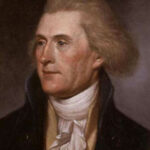Few American political movements predate Populism. The phrase would not be turned into a political party until the late 19th century, though its ideals have existed since the birth of the nation. As the author of the Declaration of Independence and a father of the American Constitution, Thomas Jefferson was the first “populist” to hold office. He believed firmly in the romantic Southern farmer and in the vital role that agriculture played in the economy. Jefferson’s mortal enemy was the financial genius Alexander Hamilton, who took a philosophy directly opposite to his. Hamilton knew that industrial dominance, manufacturing, and big business would one day create an American superpower. The feud inside the first White House represented the ultimate debate over the American economy. Jefferson and his farmer’s principles stood starkly against the Hamiltonian view of Eastern mechanization. Despite the Populist Party’s failures in the late 19th century, its reformist ideologies would have as great an impact on the American conscience as Thomas Jefferson himself.
The first major populist revolt occurred in 1791 in the rural Monongahela Valley region of Pennsylvania. The Whiskey Rebellion shocked the infant nation and brought out the plight of the poor Western settler. Secretary of the Treasury Alexander Hamilton had proposed an excise tax on liquor that required the settlers’ painstaking effort to bring their goods to market. An insurrection occurred and it was promptly put down by Washington’s army. Thomas Jefferson, ever the supporter of the common man, scorned Hamilton’s actions and stated that “a few revolutions here and there are healthy for a nation”. The lesson learned was that the American government valued industry over the simple farmer. This scenario repeated itself until the Progressive Era when populist ideas took root in all branches of the government.
The Populist Party was an evolution from the Farmers’ Alliance and the Greenback Party of the past. These groups had several common beliefs. Following the Panic of 1893 and other post-Civil War economic slumps, many farmers and workers faced sudden bankruptcy. The belief in inflation or “soft money” was a key element to the Populist agenda. With more money in circulation it would be easier for the debtors in the South and West to pay off their debts. Creditors opposed this as it would result in a loss of profit. The lower and middle classes soon realized that industrial exploitation and corporate corruption were partly to blame as well. Populists favored government regulation of businesses, especially the railroads, and an eight-hour workday. The power of the political machines in urban areas disgusted the Populists and the party campaigned for the Australian secret ballot that would diminish voter fraud. Jackson’s corrupt Spoils’ System was also on the Populist bull’s-eye. Civil Service reform was necessary to bring skilled individuals in and throw away the Mark Hannas of the United States government. Politically speaking, the Populist Party failed primarily because its voters regionally allied with the Democratic Party. Populism as a movement would survive far beyond the birth and death of the party that coined it.
The Progressives of the early 20th century took up the banners of social, economic, and political reform that the Populists had left behind in the previous century. With the rise of the middle class came the political power to achieve the old popular goals that had existed for nearly 100 years. The Suffragettes campaigned for the women’s’ right to vote and the Woman’s Christian Temperance Union trumpeted alcoholism as the source of America’s social ills. These movements resulted in the passing of the 18th and 19th amendments to the Constitution. On the hot issue of workers’ rights the AF of L and other groups influenced T.R.’s Progressive government to eliminate child labor, grant better wages, and work towards fewer hours for workers.
Muckrakers like Ida Tarbell opened American eyes to the corruption of the Standard Oil Company and other big businesses that used railroad rebates, pools, and trusts to squash competition and maintain a stranglehold on the American economy. The efforts of Muckraker reporters pushed the Progressives to pass anti-trust legislation that increased in ferocity under Taft and Wilson’s “New Freedom” administration. The establishment of building codes worked to solve the problem of the slums in the Megalopolis. A political cleansing of the civil service department began to wash away the soot of Grant’s old corruption by electing Progressive leaders. The Populist vision of a graduated federal income tax even saw ratification in 1919. Virtually all of the Populist playbook was used by the Progressives in the early 20th century.
Why was Populism the most successive failure? The answer is that the populist movement survived the Populist Party. Open up a copy of the New York Times and there is a good chance that the word “populist” is in there somewhere. The word influenced and provided the foundation for another word that is synonymous with reform- progressivism. The Populist Party failed because of its lack of money and voters’ fears of betraying the Democratic Party. The Progressive middle class was able to get rid of the chains of the political machine and pass populist reforms that benefited the majority of Americans. Populism, the agenda of the people, will always be popular.



